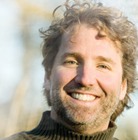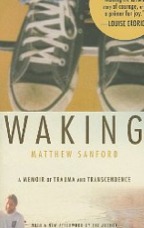
Matthew Sanford
I’ve known about a character named Matthew Sanford for a few years. He’s a forty-something Iyengar yoga practitioner and teacher in Minnesota.
Matthew is somewhat “famous” in yoga circles for his ability to teach a yoga class without doing many of the poses himself.
Matthew practices yoga daily, and has been studying yoga for about 15 years. He has lived in a wheelchair since 1979, when a car accident left him paralyzed from the chest down.
His memoir, Waking: A Memoir of Trauma and Transcendence, was given to me to read by a yoga student. I couldn’t put it down.
Matthew describes what he calls “healing stories.” These are the stories we believe that shape how we see the world and our place in it.
He says that each one of us creates a sort of personal mythology to help us define our experiences. The stories we tell ourselves can be both constructive and destructive. They can propel us forward or hold us back.
An example of a healing story could be as simple as, “Everything happens for a reason.” Or, “Why doesn’t anything ever go right for me?”
Even though I’ve never been paralyzed, I identify when Matthew describes how after the accident he viewed his body as an object.
I have so often judged my body, rather than connected to it. I leave it, rather than feel it.
He describes his first meeting with his yoga teacher, Jo. She gave him a simple pose to practice. “Shaking hands with your feet” was the first pose. He was to take his foot, put a finger between each of his toes, and form a clasp.
This pose, he says, was the hardest one to do. The hurdle was not physical. He realized that the pose is an act, a ritual, an introduction. And he noticed that there was a gulf a mile-wide between his mind and his feet.
In non-paralyzed people, parts of the body that have been avoided for years can become unconscious. I have witnessed this in myself and in yoga students that I have taught.
Yoga literally wakes up these parts of us that have been asleep. We must awaken the body, and see what comes up. The mind-body connection is strengthened every time we are willing to stay with physical sensations that come up.
Our experiences are written upon our bodies. Instead of holding the breath and pushing through any resistance, we learn to be present to learn what the resistance has to teach us.
Waking: A Memoir of Trauma and Transcendence illuminates this journey of bringing light to the dark places in the body. For Matthew Sanford, these dark spots were apparent – the black hole where his moving legs used to be.
For most of us, these places are hidden – until we start looking for them.
If Matthew Sanford can wake up from paralysis to find a mind-body connection then I know I can too.
I highly recommend this story of moving from merely surviving in a wheelchair to a thriving experience of mind-body connection.
Here is an excerpt from the book:
When yogic instruction rekindled a feeling of energetic sensation within my mind-body relationship, it felt like settling into a warm bath — the relief, the feeling of nourishment, the calm and quieting reference. I grew in dimension as my entire body began whispering ot me once again, albeit in a more eloquent voice.
The splendor and subtlely of living is most apparent in the conscious presence of the silence. Now, after thirteen years of yoga practice, not only do I feel an upward energetic release in hands-in-prayer, I also feel a downward energetic connection to the earth. Is this the same as being able to perform a complex, pretzel-shaped physical pose? Obviously not. Progress is what you make of it. (p. 168)
